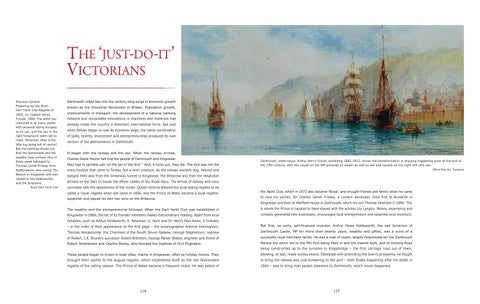THE ‘JUST-DO-IT’ VICTORIANS Previous Spread: Preparing for the Start: Dart Yacht Club Regatta of 1868, oil, Captain Henry Forrest, 1869. The artist has crammed in as many yachts with personal racing burgees as he can, and the two in the right foreground seem set to crash. Moreover, what is the little tug doing left of centre? But the painting shouts out that the fashionable and the wealthy have arrived. One of these yawls belonged to Thomas Levett-Prinsep from Staffordshire, who owned The Beacon in Kingswear and was related to the Holdsworths and the Simpsons. Royal Dart Yacht Club
Dartmouth rolled late into the century-long surge in economic growth known as the Industrial Revolution in Britain. Population growth, improvements in transport, the development of a national banking network and remarkable innovations in machines and materials had already made the country a dominant international force. But just when Britain began to lose its economic edge, the same combination of skills, talents, investment and entrepreneurship produced its own version of the phenomenon in Dartmouth.
It began with the railway and the sea. When the railway arrived, Charles Seale-Hayne had told the people of Dartmouth and Kingswear they had to sprinkle salt ‘on the tail of the bird.’ 1 And, it turns out, they did. The bird was not the
Dartmouth, watercolour, Arthur Henry Enock, exhibiting 1882-1912, shows the transformation in shipping happening even at the end of the 19th century, with the vessel on the left powered by steam as well as sail and vessels on the right still only sail. Elford Fine Art, Tavistock
mass tourism that came to Torbay, but a rarer creature. As the railway workers dug, heaved and banged their way from the Greenway tunnel to Kingswear, the Britannia and then the Hindostan arrived on the Dart to house the officer cadets of the Royal Navy. The arrival of railway and navy coincided with the appearance of the royals. Queen Victoria allowed the local sailing regatta to be called a ‘royal’ regatta when she came in 1856, and the Prince of Wales became a loyal regatta-
the Yacht Club, which in 1872 also became ‘Royal’, and brought friends and family when he came
supporter and placed his own two sons on the Britannia.
to race his yachts. Sir Charles James Freake, a London developer, lived first at Brookhill in Kingswear and then at Warfleet House in Dartmouth, which his son Thomas inherited in 1884. This
The wealthy and the entrepreneurial followed. When the Dart Yacht Club was established in
is where the Prince is reputed to have stayed with the actress Lily Langtry. Money, experience and
Kingswear in 1866, the list of its founder members makes extraordinary reading. Apart from local
contacts generated new businesses, encouraged local entrepreneurs and spawned local inventors.
notables, such as Arthur Holdsworth, R. Newman, G. Hunt and Sir Henry Paul Seale, it includes – in the order of their appearance on the first page – the oceanographer Admiral Sheringham,
But first, an early, self-financed inventor. Arthur Howe Holdsworth, the last Governor of
Thomas Woolacombe, the Chairman of the South Devon Railway, George Stephenson, nephew
Dartmouth Castle, MP for more than twenty years, wealthy and gifted, was a scion of a
of Robert, I.K. Brunel’s successor Robert Brereton, George Parker Bidder, engineer and friend of
successful local merchant family. He was a man of vision, largely responsible for the Dartmouth
Robert Stephenson and Charles Manby, who founded the Institute of Civil Engineers.
Market Act which led to the Mill Pool being filled in and the market built, and to Victoria Road being constructed up to the turnpike to Kingsbridge – the first carriage road out of town,
These people began to invest in local villas, mainly in Kingswear, often as holiday homes. They
allowing, at last, ready access inland. Obsessed with promoting the town’s prosperity, he fought
brought their yachts to the August regatta, which established itself as the last fashionable
to bring the railway and coal-bunkering to the port – both finally happening after his death in
regatta of the sailing season. The Prince of Wales became a frequent visitor. He was patron of
1860 – and to bring mail packet steamers to Dartmouth, which never happened.
118
119
